Keep Calm and Carry Ohm
17/11/08 Day 4 - Sarnath
Keep Calm and Carry Ohm 17/11/08 Day 4 - Sarnath |
||
I woke up very tired this morning after yet another night of broken sleep. This time my mobile phone rang at 2am from a strange '3344' number? After the "Who the hell?" rant I just couldn't get back to sleep. Then there were doors banging down the corridors. I knew they were renovating some rooms on this floor but they had obviously decided to start working 24 hours a day. Julie slept blissfully through it all! My head was now as fuzzy as the Delhi smog which was considerable. Bleary eyed we went down for breakfast where it appeared the United Nations had landed. I half expected to see Ban Ki-moon arriving any minute. |
| Large African ladies in bright floral dresses towered above short suited Japanese men, who stood alongside proud Arabic gentlemen in their traditional attire, waiting for an omelette. It was great people theatre. They must have all been delegates for some international conference. For breakfast this morning I tried some different. I had Upma, a savoury semolina pattie, a few paneer pakoras and a Dal Samber. Still hungry for culinary adventure I went back for a bowl of porridge. It was ice cold, exceptionally sweet, delicately fragranced with cardamom and laced with juicy sultanas and a few seeds. Whilst it looked like a bowl of cold sick it was very nice. Honestly! |
| As we sat in the busy departure lounge Rob mentioned that he thought this plane was going to two destinations, Kajuraho and then on to Varanasi. "Oh my God, an up and a down in the middle" said Julie as she reached for an extra diazepam. That's (one of) her worse flying nightmare, to have to land and take off in the middle. That's doubling the risks! At least she had the comfort of premier class seats in which to shit herself! If she was going to die, she was going to do it in style. The width of the seats and leg room to stretch out was exceptional. The service was also first class. As soon as we had sat down we were served a glass of sweet lime juice, given a refreshing hand towel and a menu to choose what to have for lunch. "This is lovely" I purred. "It can still crash" was Julie's tense reply. |
This was our first ever premium class flight. Our uncharacteristic extravagance was actually down to our late booking of the tour. The only seats available on this Jet Airways flight were the posh ones so we had to pay over £45 extra each. Which was quite reasonable we thought. Shortly after take off our lunch was served. The lap tray was expertly extended for us, a white linen table cloth was laid, china tea cups and silver plated cutlery were arranged precisely. Very classy. The standard slipped slightly when the vegetarian choice was a peculiar Paneer Masala filled croissant. It was a fusion of tastes that went too far. Yes, that's right, it was a taste con-fusion! |
|
|
He parted the waves and led us through the hordes to our car. Our brand new Italian designer luggage (from discount store TK Max of course) had already been roughed up and dirtied by this morning's flight but they now found themselves up on the roof. The drive from the airport to our hotel took us 30 fascinating minutes through several rural villages. A lively and exciting journey spent mostly hurtling head-on towards oncoming traffic beeping our horn furiously. Our driver was obviously quite experienced at this death defying manoeuvre. We were in safe hands. |
||
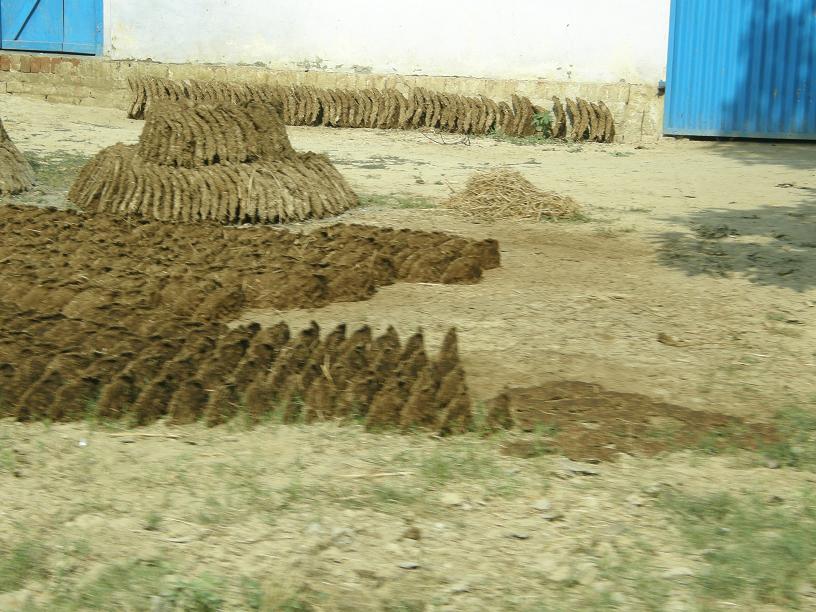 |
There were a lot more cows wandering the streets here. Their sacred hides better protected perhaps by the nearness of the holy Ganges. Plenty of cows always means plenty of cow dung and they were certainly making good use of it. We saw many mounds of these neatly packed triangular cow dung patties (or shit bricks as I prefer to call them), drying out in the sun. Whilst the modern world believe to have invented biofuel its been used here for thousands of years, known as goottie it's used mostly to provide the heat for cooking. |
Speaking of which, we saw plenty of roadside cafes in amongst the dust and the dirt, cooking with their goottie fired stoves. Despite being more than a little hungry I somehow managed to resist the temptation and didn't ask the driver to pull over. Mostly because I didn't want to distract him from the wacky races we were involved in. "Keep your eyes on the road and your hands on the horn!" Unfortunately, most of the villages we passed through were either a high speed blur through our window or were obscured from view by large colourful lorries. Blink and you've missed another photo opportunity. |
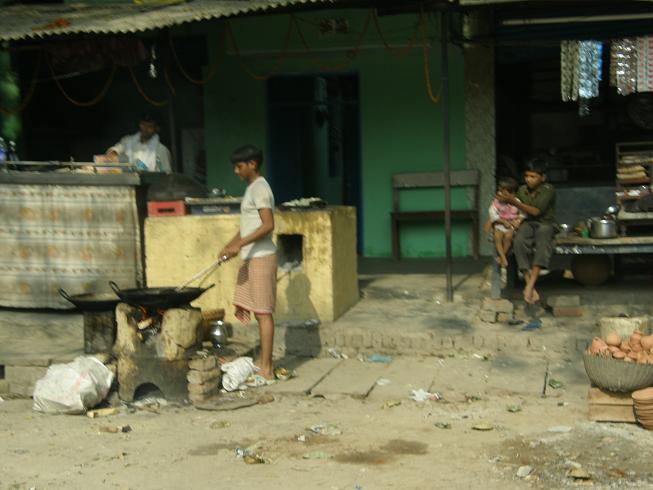 |
| The city is also commonly known by two other names; Kashi, which translates to the 'City of Lights', but it's more popularly known as Benares, a name the Mughal empire bestowed upon it and survived until India's Independence in 1947 when it reverted back to the traditional Hindu name of Varanasi. As we crossed the bridge we entered the Cantonment district and came to a full stop at a gridlocked five point junction. It was absolutely chock-a-block as we slowly edged our way closer to our hotel. Whilst such a delay would usually be frustrating, here in India the slow moving traffic was an opportunity to get a better look at the world around us. |
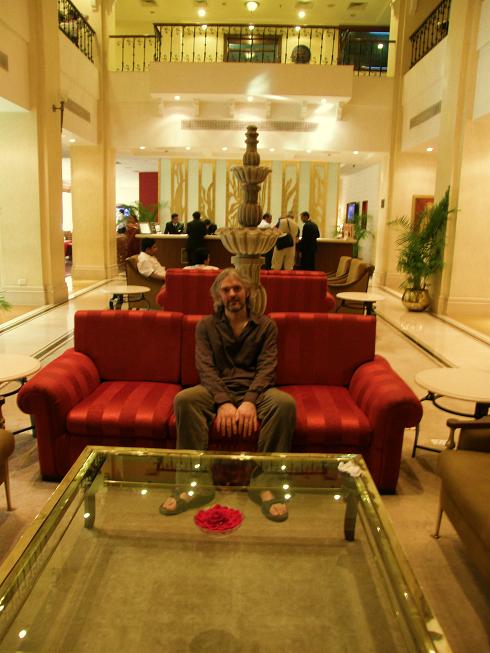 |
We arrived at the Radisson hotel and sat down in the foyer whilst our rep took care of the formalities. As we sipped our tepid welcome drink of flat coca-cola we watched another couple arrive. In stark contrast to our reception they were greeted like royalty, receiving a bindi on the forehead, a fresh orange blossom garland, a bouquet of fresh lilies and a glass of refreshing sweet lime juice. "Well, look at them, Radisson's Much Preferred Guests or what?!" we joked enviously. With our key in our hand we went up to our room. We had been given rooms next to Rob & Carol and only after combusting in the toilet did I noticed that we had a flimsy connecting door between us. "Oh my God, I hope they didn't hear what I just did!" But being 5.6 on the richter scale they must have! |
| The room itself was fine but we were in for one hell of a shock when Julie opened the curtains. We stood face to face with labourers only a few feet away carrying bricks on their heads on their way up to the top of the adjacent building. This must have been the worst view from a hotel room ever! Julie quickly shut the curtains not to be re-opened again. |
Within a minute I heard a familiar voice "Where you going ?" I turned around to see the rickshaw peddler with a beaming smile. We both burst out laughing. He still followed me all the way down to the junction but instead of hasslling me he struck up a conversation "Where are you from?" "How long are you in Benares?" When we reached the junction I thought he was going to hug me as we had become instant best friends but we just shook hands and went our seperate ways. |
I took the first exit, aiming towards a Methodist church but I ended up walking into the middle of two lanes of oncoming traffic. I took it in my stride however and was practically a local as I skipped across the road to the other side and hurdled a wall to get to safety. After walking across a small piece of wasteland I reached Raja Bazar Road and began walking towards a white spire in the distance. It was a Sanskrit University called Anand Mandir. Sanskrit is an ancient language that is mostly kept alive in scholarly circles similar to Latin, I suppose. |
It didn't look that far away but after walking for five minutes it didn't seem any nearer. I wasn't going reach the seat of linguistic learning any time soon so I turned around and made my way back to the hotel. Walking down the crowded street was fascinating, even exciting. Although it was also equally intimidating. Not once did I feel worried or threatened but it was just the way that all the eyes were fixed on me. When I made eye contact with someone they would just stare back at me. An unblinking gaze that was a little unsettling. |
| In a game of "who blinked first" I lost every time! I tried to make friends but my nervous smile was never reciprocated. Everyone seemed so unapproachable. I was probably getting funny looks because I was photographing everything in sight. |
I chose not to take advantage of the refreshments on offer at the Royal Cafe and continued my way back towards the Varuna river and our hotel, now trying to avoid eye contact and concentrating on the pavement and the rooftops. In doing so I came across a Royal Enfield motorbike parked at the side of the road. Those who like their bikes like the Royal Enfield. It's famous as the oldest motorbike brand name in the world. Established in the 19th century and the pride of the British but since 1970 its been manufactured exclusively in India. The original Bullet design still being faithfully reproduced. |
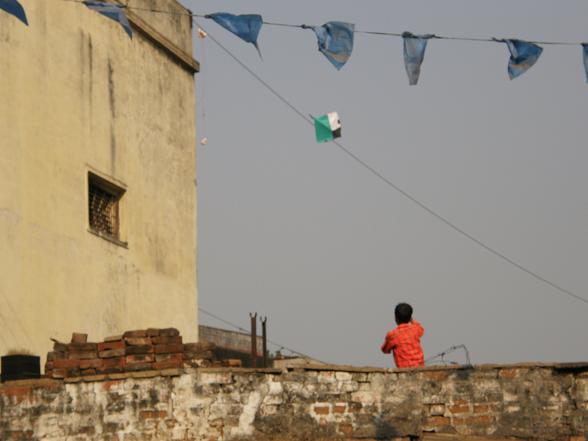 |
A little further along I caught a glimpse of a young boy up on the roof practicing his kite flying. I had just finished reading "The Kite Runner" and this was wonderfully evocative. It was my turn to stand and stare. I lost track of time as I was hypnotised by the swooping kite. Once I snapped back to the here and now I put my head down and marched back to the hotel as quick as I could. I had been gone over half an hour but Julie was fine, she was enjoying the relaxing atmosphere of the lounge, sipping another cup of Darjeeling. |
| Rob and Carol joined us as we waited for our 3pm pick up for our trip to Sarnath, a sacred Buddhist pilgrimage site. The fact that this escorted tour gave me the opportunity to visit the site of Buddha's first sermon was a big reason why I chose this tour over others. I'm not a practicing Buddhist by any stretch of the imagination but I certainly wish I could allow it to influence my life more than it does. I wish I could put into practice all that I find true with this wonderful philosophy. |
| Our guide, who's name sounded strangely like Hamish, but I'm sure was Harish, spent the journey to Sarnath teaching his captive audience about the Buddha's life. Born a privileged prince, Siddhartha Gautama renounced his life of luxury after witnessing the suffering of ordinary people. Leaving his family behind to find the meaning of life he wandered Northern India until it all came clear to him. His moment of enlightenment took place at Bodhgaya after sitting beneath a tree for many many days. Flushed with his new idea he travelled to a deer park at Sarnath to deliver his first sermon to old friends he made during his wilderness years. |
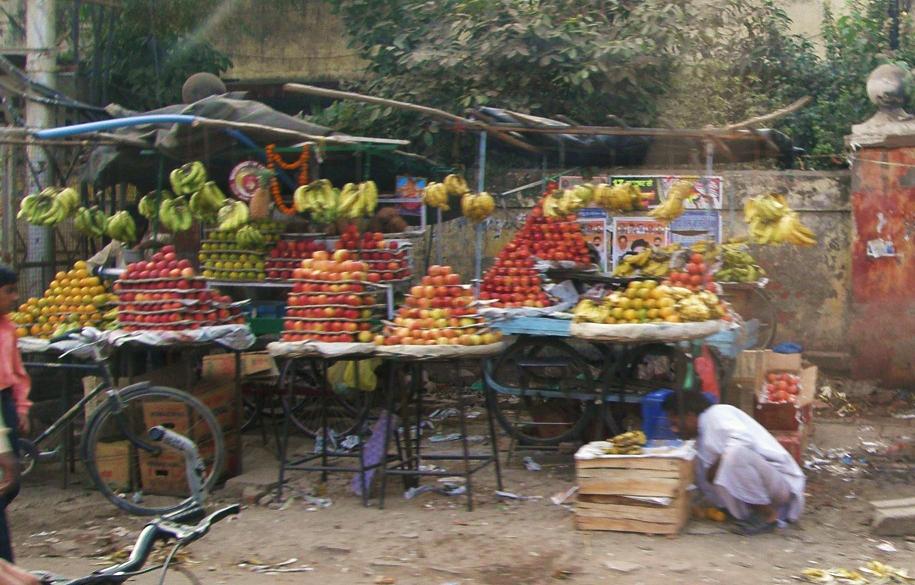 |
His message was "I have seen the truth and this is what I know". In time it came to be known as the four noble truths, the basis of Buddhist philosophy 1.) There is suffering 2) The reason for suffering is our attachment 3) Freedom from suffering can be achieved by letting go of our desires and 4) the way to reach this state is by following the middle way, avoiding the extremes of self-indulgence and self-mortification and focusing on what is known as the Eightfold Path, right views, right discrimination, right speech, right action, right livelihood, right effort, right mindfulness and right concentration. |
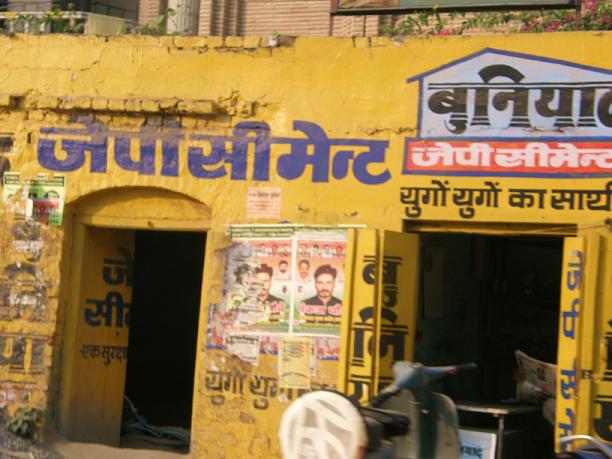 |
"Save yourself ... within yourself" repeated Harish as a mantra he held close to his heart "the answer is letting go." It was a lot of information to take in over the short twenty minute journey! I was interested to hear him explain the decline of Buddhism in India and how the Buddha was absorbed into the Hindu religion as the 9th reincarnation of Lord Vishnu. So whilst people worship the Buddha as part of their Hindu faith only 2% of India's population are exclusively Buddhist. That still makes it 24 million people in this insanely overpopulated country! |
We arrived at Sarnath but before we entered the deer park we first visited the Archaeological Museum. It was built to house all the items excavated from this site by the Asiatic Society, an organisation established in 1784 by the vision of Sir William Jones, son of a Welsh mathematician who was born in the small parish of Llanfihangel Tre'r Beirdd on the Isle of Anglesey. A small parish where Julie's brother David got married and a few miles from where my mother was born. What a wonderfully tenuous link! |
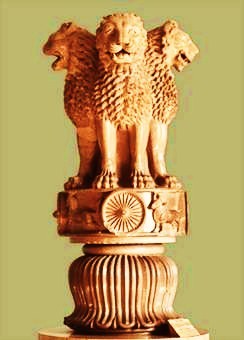 |
The first item to grab your attention as you walked in the museum, (not because it was right in front of you but because it was both magnificent and instantly recognisable ) were the famous lions of Ashoka's pillar. A spectacular sculpture carved from sandstone of four Indian lions standing back to back, on top of a plinth depicting a bull, horse, elephant and a lion, each seperated by a wheel called the Dharma chakra. All of which was further atop an inverted lotus. All of this is known as the Lion Capital of Ashoka and it was adopted as the National emblem of India after independence. Ashoka is regarded as one of India's greatest emperors. He ruled during the 3rd century B.C., some two hundred years after the Buddha's time. After a bloody and ruthless battle Ashoka was disgusted with himself and the depths to which he had sunk to satisfy his desire for power and converted to Buddhism. He erected this column in Sarnath to symbolise his conversion and he spent the remainder of his reign spreading the message of non-violence, love, tolerance and vegetarianism. |
| Ashoka
went on to distribute the ashes of the Buddha to eight different sites
across India and built several other columns. This one however was the
first, the original and I felt quite privileged to have seen it. |
In addition to being the National Emblem the 24 spoked wheel or Dharma chakra from the sculpture was also placed in the centre of the newly formed Republic of India. Harish explained that officially the colours represent the soil or agriculture (green) the quality of renunciation or the state of non-desire (saffron) and the path of truth, the light (white) but some believe that the flag had been agreed before the final decision on independence split the country (by forming Pakistan, Bangladesh and India) and that the colours were for the faiths of Hindu (saffron) and Muslim (green) and the peace between (white). |
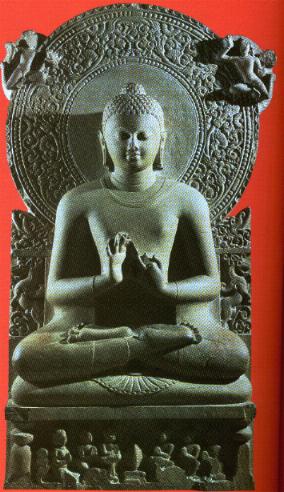 |
We walked around the east and west wings looking at the many Buddha statues. Most were quite damaged with either a nose, a finger missing or whole limbs missing. There was one however that was complete and quite inspiring as you walked up towards it. It aptly showed Buddha in a preaching pose but intriguingly he was surrounded by angle-like celestial beings. Harish told us that images of the Buddha did not start appearing until the 1st century B.C. as Buddha did not want to be worshipped as a god. He said "I am not a god. I have shown you the path but you must travel it alone." We left the museum and walked the short distance across the road to the entrance of the deer park with four extremely persistent postcard peddlers in close attendance. Stepping through the gates brought instant tranquillity. The peace and quiet of the surroundings was a welcome relief to the madness outside. |
I didn't know what to expect at the deer park. I'd not seen any photographs and as we began to walk around I realised why. It wasn't the most photogenic of places! The main focal point was the Dhamek stupa, a massive unattractive brick mound. It was of the simplest thimble design but was a solid mass not a hollow. The remainder of the area was an archaeological site, remnants of foundations. There wasn't much left of what would have been a thriving religious centre with a community of over thousand monks. |
The destruction of the monasteries and temples was not as a result of war but simply a demand for building materials. With the decline of Buddhism in India Sarnath was no longer held in high regard and when the ruler of Benares was expanding the city he pilfered here for its bricks and timber for construction. It was difficult to imagine the former glories of Sarnath. It was a shame that it hadn't been preserved but then again its was aptly symbolic of the Buddhist concept of impermanence. "Decay is inherent in all component things" |
Once Harish had finished informing us about the history we wandered off on our own to explore the ruins. We strolled around but other than red brick there wasn't much to look at really; that was until we turned a corner and stumbled across a simple altar. There were no statues nor ornaments only some gold-leaf on the brick wall. The overwhelming sweet smell of incense and the flickering of dying candles created an incredibly spiritual atmosphere. It was perfect. |
We wished we had more time to just sit down and absorb the sensations but we had no time to relax, we had to move on. We were against the clock. As we walked towards the stupa I caught a glimpse of an intricate carving of the Buddha hidden amongst the red bricks. It was no bigger than the palm of my hand but was quite a thrill to discover! I felt like I had stumbled across something the tomb raiders had missed! As we stepped up out of the excavations we were approached by a young boy who offered to sell us a crudely carved statue. I politely turned him down with a flat "No thank you" |
He tried his luck again with "I give you a good price" but when I turned him down again with more sternness he reached into his pocket and pulled out a far finer piece. He said nothing but threw his eyes in the direction of the excavations, suggesting that it came from the archaeological site. Part of me wanted to grab him by the ears and drag him to the staff at the gate but I didn't. I just gave him a disgusted scowl and a growl and he scampered off. It's a thin line between little rascal and thieving bastard. |
We had now reached the base of the stupa where a monk dressed in his burgundy robes walked clockwise around the base. It's traditional to hold the focus of the pilgrimage to the right of you out of respect, so we followed his example and walked in the same direction. This close up the stupa wasn't as plain as it looked from distance. A sprinkling of gold-leaf brought some colour to the walls, a block of inscription added interest and a few empty recesses hinted at its past. We didn't quite complete a full circumnavigation. We were running late and had to leave our circle halfway through to take the quickest path to the exit. |
Of
course I believed hook line and sinker, the fact that the large tree in
front of me was a direct connection to such a divine moment in history
raised my goosebumps. |
Pilgrim savvy by now, we walked around the bodhi tree clockwise. That was until we came across of prayer meeting and we didn't know where to put ourselves. Determined to complete a full circumnavigation we tipped toed through the knelt congregation. |
Fortunately
most had their eyes closed in prayer so unless they had their third eye
open hopefully they didn't even know we were intruding on their service.
|
|
At the end we reached a pagoda, or a shelter, where inside sat a statue of Buddha delivering his sermon to his five kneeling disciples. They were all painted in life-like colours which is a very Burmese style. Harish explained that they were in fact gifted by the Burmese Buddhist Society. I especially liked the fact that they all had grey hair! We left the Bo tree behind and made our way to the main temple. |
| Before leaving I stopped at a small table selling Buddhist gifts such as prayer beads, small statues and a large selection of books. |
I took my time perusing the many titles and settled on buying The History of Buddhist Philosophy. I also wanted to buy some beads from here, the "Birthplace of Buddhism", to replace (when they break) the ones I have worn on my right arm for the last eight years. (I bought my current ones at the Opium Museum in Sop Ruak Thailand and haven't been a day without them.) The sun had now set and it was time to leave for the hotel in another death defying race across to Varanasi. |
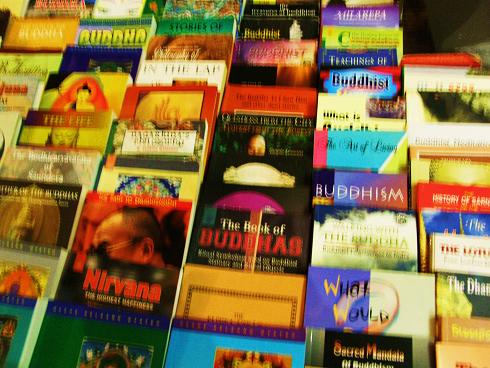 |
|
Along the way Harish did offer to stop at a silk shop but only if we were interested. After the magic carpet experience in Delhi we graciously declined the offer. When we reached the Radisson at 6:30pm the first we needed was food. We hadn't eaten properly since breakfast. (I'm not counting the curried croissant as a proper meal!) |
| The hotel had two restaurants on offer, the Sunflower Cafe offering a buffet of international food including Indian, and The Great Kabab Factory celebrating the best of Indian kebab cuisine. |
| Unfortunately we had to wait for the restaurant to open. I survived by eating the biscuits that came with the complimentary tea making facilities in our room. At 8pm we went down to the mezzanine level to have a look at the Kebab house menu. There was a vegetarian and non-vegetarian section which was encouraging and despite the high ratio of unfamiliar dishes I was still drooling uncontrollably. We were greeted warmly by front of house but were shown to our table by a guy who looked more like a mechanic than a waiter. We noticed that all the waiting staff looked like a troop of oompa-loompas dressed in their blue boiler suits. It was a very unattractive look! We were seated at a table in the corner. There was only one other table occupied in the restaurant. "Would you like the vegetarian or non-vegetarian menu?" asked the waiter. "Vegetarian please" replied Julie. Off he went, returning within a minute, not with the menu but with our first course!? |
|
It began with a green salad dressed in a spicy pineapple sauce with a small portion of a potato and tomato rice dish (Aloo Tamatar Ki Teheri) As soon as we cleared our plates out came the next course; lovely slabs of paneer tikka (Chutneywala Paneer Tikka) quickly followed by a tasy paneer curry (Paneer Do Pyaza) and delicious braised potatoes in tamarind (Imli wale Aloo). The potato dish reminded me very much of something my mother used to cook on a Monday called 'tatws pum munud' only they were braised in beef stock left over from the Sunday roast. |
The feast didn't stop there! Next up were a selection of kebabs. We had a skewered spinach and lentil kebab (Hare Moong Ki Seekh) which looked like a funny green sausage on a stick; a vegetable sausage on a stick (Subz Galouti Kabab) and spiced carrot pattie (Gajar Sal jam Ki Shami) And still the gastronomical adventure continued. There was a team of waiters serving us by now and as one waiter arrived with two containers of dal offering a choice of either a Dal Tadka or a Dal Factory (the house dal) another cleared our kebab plates and asked if we would like some more kebabs? |
|
In an instinctive reaction I answered "Oooh, yes please" We were then surprised when the chef came out to check if the spice levels were to our taste. "Not too spicy?" he asked. "No, they were delicious" we both mumbled with a mouth full of Subz Galouti Kabab. Unbelievably, the dal waiter then returned asking if we wanted more. Even more unbelievably I couldn't say no! So another ladle of dal and naan bread was served. It was now getting a bit silly because I'm sure we could have eaten all night if we wanted. It then dawned on us that we didn't really know how the price was structured so we decided to say "No" the next time we were offered more food. Once our plates were empty they tried again to tempt us with some more Paneer curry or Imli wale Aloo but we showed admirable restraint and turned him down. We thought it was all over ... but it wasn't. It was now time for dessert! Julie couldn't eat another morsel so it was down to me to eat double portions of a cardamom infused milky lollipop (kulfi .... on a stick I suppose), a dollop of warm caramelised semolina (?) and the piece-de-resistence, a wobbly mound of white creaminess the waiter called "milk fat". Once I had finished they actually asked if I wanted more! Incredible! I couldn't possibly have eaten any more. It was time to leave and go for a lie down so we asked for the bill before one of us burst a gut. We were very surprised to discover this entire banquet, fit for a maharaji, was only 445 rupees each. That was staggeringly good value! Back in our room at 9pm Julie fell straight to sleep. I soon followed after writing up today's journal. I was dreaming about a good night's sleep when I was again woken up by a bloody phone ringing. This time it was Julie's mobile and was a text from vodafone reminding me to stay on their network. It was a conspiracy to stop me from sleeping through the night! |
| Next Day > | ||
|
ęCopyright 2000 - 2020 |